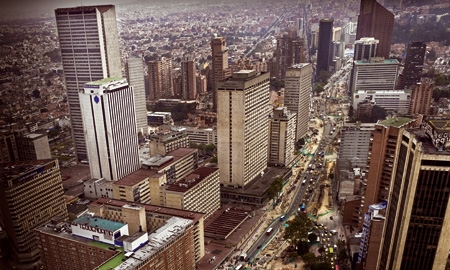Amid booming economic growth, the Latin American nation of Colombia is increasingly becoming an attractive location for international investors, drawn not only to its sustained political and financial stability but also to its developing modern infrastructure and open market.
Last year, Colombia experienced a growth in GDP of 5.7 per cent, up from 4.6 per cent in 2010. The current administration, led by President Juan Manuel Santos Calderón, has taken significant strides to maintain constant economic growth in addition to controlling inflation, currently at 3.7 per cent, and unemployment at 9 per cent.
According to the country’s Vice President Angelino Garzón, Colombia is expected to maintain its economic growth at an average of 5.5 per cent annually, perhaps seeing as much as 6 per cent in the upcoming fiscal year.
Much of this economic growth is due to a flourishing and diversified export industry, which totalled $55 billion last year.
Mining and oil, as well as food, coffee and heavy industries, are the key motors of the country’s international trade. Colombia is also the fifth-largest exporter of coal in the world, relying on its strategically placed ports along both the Pacific Ocean and the Caribbean Sea for international shipping.
These rich industries are, however, only part of reason for the economic success. The government’s policy has also played an important role in creating an environment conducive to trade. Colombia has implemented an open-door policy with the international market including Europe, the United States and Asia.
Whereas certain countries in South America are implementing policies of protectionism, for example Argentina and Venezuela, other nations in the region, such as Peru, Chile, and Colombia emphasise cooperation and international exchange. In May this year, Colombia signed a free trade agreement (FTA) with the United States, making the country a potential hub for other investors in Latin America.
“We put a lot of importance on signing bilateral free trade agreements,” remarks Mr Garzón. “Last year FTAs went into effect with Switzerland, Canada and the US.”
Mr Garzón adds that negotiations are taking place throughout various regions of the world, including Turkey, Japan, China and Russia.
Germany is also currently participating in negotiations for an FTA between the EU, Colombia and Peru, discussed during a meeting between German Chancellor Angela Merkel and Colombian President Juan Manual Santos.
Featured in TIME magazine this year as one of the 100 most influential people in the world, President Santos, along with his administration, has made international cooperation one of the key points of his economic platform, aiming to further boost the country’s exports and attract more foreign direct investment (FDI).
Last year Colombia ranked fifth worldwide in terms of FDI growth, rising 24.8 per cent in the first two months of this year. Foreign investors see Colombia as a secure and promising investment, enjoying political and legal stability, with the most popular sector for FDI being energy.
Within the region there has also been significant growth. Between 2010 and 2011, investments in Latin America and the Caribbean grew by 35 per cent. In 2011, Colombia received almost $15 billion in FDI, experiencing some of the highest growth in the area and reaching record levels.
Much of this new wealth is being put into social programmes, such as education, or infrastructure projects. President Santos has shown a firm commitment to curbing human rights violations, as well as closing the gap in socioeconomic inequality. His administration has also allocated significant funds toward building infrastructure, such as modernising and extending the motorway system and expanding the airports in the larger cities.
These improvements in infrastructure are not only important for investors, but also facilitate the increasing number of tourists visiting the nation each year, including the largest European group to visit the country, the Germans.
Medical tourism is also a thriving sector in the Colombian economy, attracting an unprecedented number of international patients, often coming for cosmetic procedures. Healthcare in the Latin American country is modern and technologically advanced, yet costs usually a fraction of the price as in the United States or Europe.
Although Colombia has had difficulties in salvaging its reputation after some difficult years, now, with the help of its international economic partnerships and increase in tourism, it is becoming clear that the Latin American nation has transformed into one of the most prosperous spots in the region.

1 COMMENT
Congratulations on this special report!! I had always though of Colombia as a drug traffickers no man's land!! :S